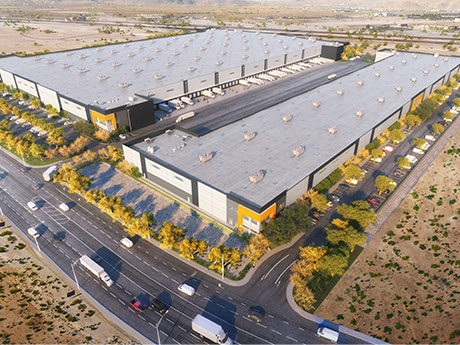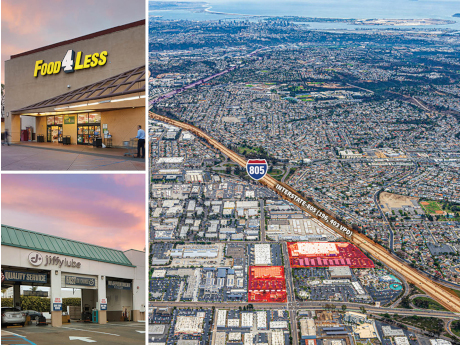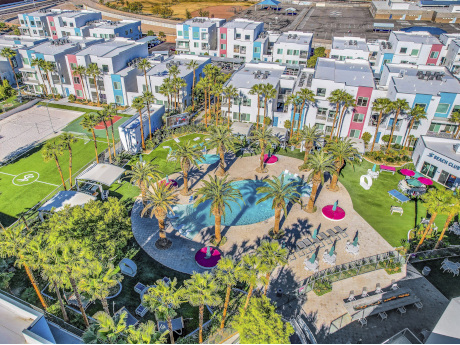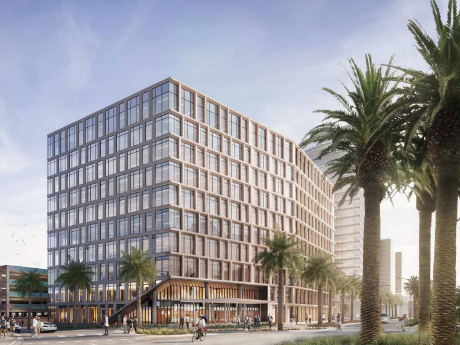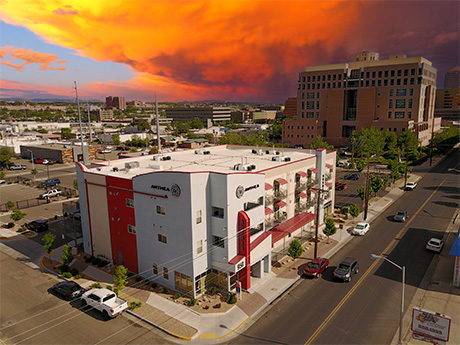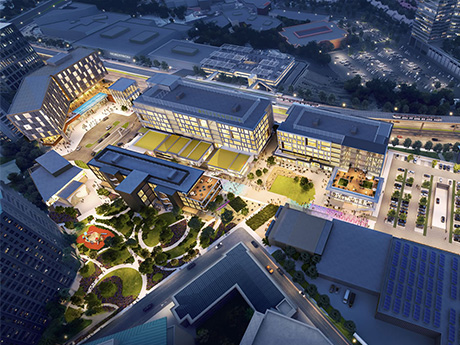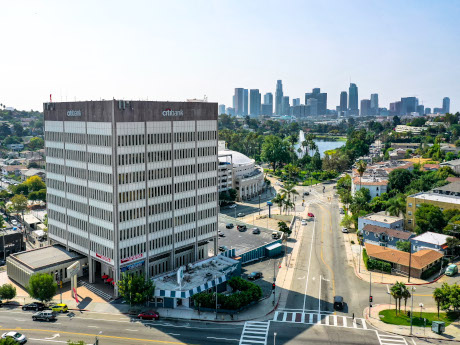By Paul Sweetland, Senior Vice President, Colliers After a record year in 2021, Southern Nevada’s industrial market does not appear to be slowing down. The first-quarter vacancy decreased to 1.7 percent with 2.9 million square feet of net absorption. This is the lowest vacancy rate we have ever recorded in Southern Nevada. For comparison, vacancy only went as low as 3.1 percent during the boom that preceded the Great Recession. Demand was positive for all industrial subtypes for the first quarter, while rents for warehouse and distribution space increased 46 percent year over year. All industrial sectors added jobs on a year-over-year basis, with the largest increase being in logistics, which added 8,100 jobs. The current industrial boom has been driven by the influx of relocations and expansions from all over the U.S., but primarily from California. Southern Nevada’s strategic location, with its ability to service 12 markets within one day, has also made it an ideal location for regional and national distribution. New industrial completions totaled 2.1 million square feet this quarter, almost all of it being warehouse/distribution product. Southern Nevada is in its third major wave of post-Great Recession industrial development, with more than 8 million square feet now under …
Western Market Reports
By Chad Iafrate, Executive Director, and Phil Lyons, Managing Director, Cushman & Wakefield Retail leasing and investment sales transaction volumes continue to increase in 2022. This growth trend began to surge in the second part of 2021 following the pandemic recovery. Retail vacancy rates in San Diego County have decreased quarter over quarter to 5.9 percent, with vacancy lowest among power centers and strip centers. Asking rental rates, meanwhile, have increased across the county. This is primarily driven by significant rent growth at lifestyle centers (+5 percent from the previous quarter) and neighborhood centers (+2.8 percent). All major retail use categories seem to be back in expansion mode after four consecutive quarters of positive absorption. Pent-up consumer demand, stimulus and liquidity have all helped fuel growth plans in the retail sector with tenants continuing to try to make up for the lost year during the 2020 pandemic-related lockdowns. Suburban shopping centers have been the beneficiary of the work-from-home model as employees who would typically frequent retailers near their offices have pivoted to restaurants and shops closer to their residences. Investor confidence in retail centers also continues to increase, most notably from rising REIT activity and exchange buyers. Local retail investment …
By Adam Schmitt, First Vice President, CBRE | Multifamily Investment Properties The multifamily construction pipeline in Las Vegas has ramped up in recent years and continues to be robust. Apartment developers have long capitalized on the growth of the Las Vegas market, and with the vast potential remaining in the city, multifamily builders are continuing to place their bets in Vegas. Our team at CBRE tracked a total of 4,317 multifamily units constructed in 2021, and are projecting more than 8,000 in 2022, with at least 16,000 in 2023 and beyond. For reference, over the past 10 years, the Las Vegas multifamily market has delivered about 3,700 annual units on average. The projects being built in Las Vegas are predominately luxury, Class A developments that tend to cater to the lifestyle renter or renter-by-choice demographic. The locations of these developments are mostly concentrated in the Southwest and Henderson submarkets, comprising 62 percent of the construction pipeline. Developers have historically flocked to these submarkets because of the areas’ respective demographics, perpetual growth and strong multifamily fundamentals. More recently, multifamily developers have found opportunities in the Northwest and North Las Vegas submarkets as those regions have seen years of high rent growth, and the rent …
By Ryan Sarbinoff, First Vice President and Regional Manager, Marcus & Millichap A growing, educated local labor force and lower rents compared to other office hubs in the region are driving office tenants to Las Vegas. The metro registered the largest drop in office vacancy among major U.S. markets over the 12-month span that ended in March, as tenants absorbed more than 2 million square feet. Much of this space was at Class B/C properties, with the subsector noting the strongest four-quarter span for demand on record. The resulting 330-basis-point reduction in overall availability during the year-long period slashed vacancy to a more than 15-year low of 12.4 percent, enhancing the sector’s outlook heading into the second quarter. The metro’s second-largest submarket by inventory, Southwest Las Vegas, exemplifies the strength of the local office sector. During the past year, the area accounted for half of the metro’s 20,000-square-foot-plus lease executions. International Gaming Technology’s sublease of a three-story building highlighted recent activity, with VisCap Media, Agilysys, DraftKings, Kiewit and Molina Healthcare all making notable commitments that dropped vacancy to 9.4 percent in March. Apart from leasing, this submarket is also the center of development. Roughly 60 percent of the space slated for completion …
By Nellie Day All of Los Angeles County might have been under the same restrictions throughout the pandemic, but their emergence from this period reveals a lot about the localized retail environments. “Los Angeles’ retail market has weathered COVID better than many other markets around the country,” says Matthew May, founder of May Realty Advisors in the Los Angeles submarket of Sherman Oaks, Calif. “However, the recovery has favored a diverse group of suburban markets.” Certain Suburbs Stand Out Markets like East Hollywood/Silver Lake, Inglewood/South LA and Santa Clarita boasted the highest 12-month rolling net absorptions in the county, according to CoStar — something May doesn’t believe was expected. “LA is known as a melting pot and this is reflected in the geographic and ethnic makeup of the top submarkets based on net absorption,” he says. “Vacancies in many of the suburbs were substantially less than in the Central Business Districts and tony retail areas from Beverly Hills to Abbott Kinney. These emerging markets were quite a surprise.” On the other hand, metro markets like Santa Monica, Downtown LA and Koreatown each had more than 100,000 square feet of negative absorption. Santa Monica’s Third Street Promenade has been one of …
By Alex Pulliam, Land & Industrial Advisor, NAI SunVista It’s been a long time coming. Albuquerque hasn’t built speculative distribution warehouses in nearly two decades. However, the recent strength of the market is giving developers confidence to break ground – and investors are paying attention. Industrial activity has been lively, thanks to accelerated macro trends from the pandemic, as well as the legalization of recreational cannabis. Albuquerque’s industrial vacancy rates have remained below 1 percent for over two quarters. Prior to that, vacancy rates hovered around a then “historic low” in the 2 percent range since September 2019. The demand from users has continued to climb and tenants are facing lease rate increases. While needing more speculative warehouses should be a matter of basic economics, it is not always easy to build in a tertiary market that lacks the memory of growth. Historically, Albuquerque would only secure a few 50,000-square-foot users per year, along with the occasional 100,000-plus-square-foot user. This deterred developers from taking a chance on new construction. But times are changing. Large tenants are taking note of Albuquerque’s access, affordability and workforce, while existing users are seeking modern buildings for efficiency and growth. These factors, combined with rental rate …
Companies, Investors Court New Mexico’s Multifamily By Todd Clarke, CEO, NM Apartment Advisors Strong employment and changing post-pandemic lifestyles have led to a surge of demand for New Mexico’s multifamily rental market. Investments made more than a decade ago are paying off from SpacePort NM and the NM Rail Runner, as well as the film and television industries, which have made New Mexico the third best place to film in the country behind Los Angeles and New York. Although Santa Fe — the fifth best international destination and oldest state capital — remains undeserved by more than 6,484 units, the market is on track to deliver 1,500-plus units. This is well ahead of Albuquerque’s less than 1,000 new units. More development will hopefully continue, thanks to a new Integrated Dynamic Ordinance (IDO, or zoning), recent investments in mass transit expansion lines and a vibrant tech eco-system at the Innovation District in downtown Albuquerque. Several major employers have announced expansions in the market, including Intel (750 jobs), Netflix (3,000 jobs), Facebook/Meta (35 IT jobs, 1,500 construction jobs) and Amazon (four distribution facilities totaling more than 3,500 new jobs). Based on historic benchmarks, this creates an acute housing shortage in Albuquerque. Recent …
By John Hickman, Managing Director, NewMark Merrill San Diego may be California’s second most populous county, but you wouldn’t know it by strolling through one of its many business districts. The county has grown up since its early days as a small military outpost, yet today its hundreds of communities and neighborhoods still impart a small-town feel. The retail real estate market reflects an intimate beach town vibe with a tightly knit brokerage and landlord community. Brokers and investors can cover the market with a limited footprint, while many retailers can achieve a major presence with a handful of locations. This is opposed to the dozens of locations they may require in other California markets, such as Los Angeles, Orange County and the Bay Area. And big, national brands aren’t the only retailers finding success — 98 percent of firms in San Diego are small businesses. Retailers in San Diego are open to taking chances on new concepts and structuring different types of leases. They’re also willing to pay slightly higher rent to gain access to the area’s strong demographics and limited supply of new shopping centers. This uniqueness provided resiliency during the pandemic and will contribute to a thriving …
By Jerry Holdner, Southern California Region Lead, Avison Young The Greater Los Angeles office sector is experiencing a fragmented and slow recovery post-pandemic as the fallout is being addressed in various ways by office tenants, investors and owners. The first quarter of 2022 ended with a 15.4 percent office vacancy rate, which was up from 15 percent at the end of 2021. It is also up from the previous high of 13.1 percent that was recorded in 2010. We started to see several companies require their employees to return to work at least in some capacity in the first quarter, which typically included a hybrid schedule. With gas prices soaring and an extremely competitive job market, hybrid situations have been significant bargaining chips for employers to attract and retain employees. That said, we don’t see leasing demand returning to pre-COVID levels for at least 12 to 24 months or longer. Office occupiers have and will continue to evaluate both their short- and long-term occupancy strategies. With all indicators pointing to hybrid work remaining indefinitely, office users are seeking to reduce their footprints. This typically involves a flight to quality as office rents are low and concessions are consistently on the table for new leases …
By Kimberly Stepp, Principal, Stepp Commercial The strength of the Greater Los Angeles apartment market has exceeded expectations coming out of the pandemic. Despite reports of an exodus from California and population decline in the metro, apartment rental demand is seeing an all-time high, with net absorption of units running at its highest level in decades. As a result, vacancy is at a low 3.4 percent, lower than the pre-COVID level of 4.4 percent. Asking rents have seen a 7.7 percent growth over the past 12 months, while the national rate is 11.1 percent. Average monthly asking rents across LA County stand at $2,130, albeit still lower than the median monthly home payment of $2,659. Los Angeles multifamily market fundamentals remain favorable for investors. The area has one of the highest percentages of renters of any U.S. metro, comprising approximately half of all households. Already hefty housing prices in a highly competitive market have seen even greater increases over the past 20 months, resulting in a median home price of $795,000. This has left a significant part of the population priced out of homeownership. High construction costs, NIMBY sentiment and onerous permitting continue to plague the ability to deliver desperately needed housing units. …


